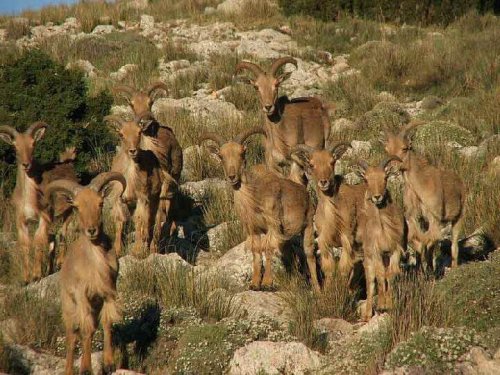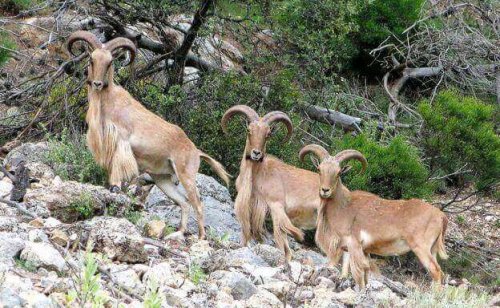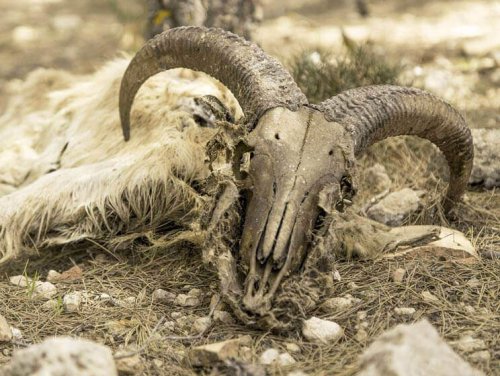Barbary Sheep - An Invasive Species?


Written and verified by the vet Érica Terrón González
The Barbary sheep were an invasive species for years, but this is now a subject for debate. So, are they truly invasive or not?
Generalities
The scientific name for Barbary sheep is Ammotragus lervia and it belongs to the goat family. Furthermore, they’re native to the African continent. Let’s highlight some of their characteristics:
- Firstly, adult males can weigh up to 320 pounds.
- Also, their fur is very short, either reddish or light brown — similar to the color of the desert sand where they usually live. Their tail is woolly and long and both genders have a beard and curved horns. Those in males are only slightly longer than in females. These horns can reach up to a couple of feet in length.
- In addition, this is a strictly herbivorous animal who feeds on lichens, herbs, branches, leaves, and berries.
- Also, they live in more or less numerous, mixed groups of all ages, composed of males, females, and youngsters. The females are the leaders of the groups and usually have one lamb only.
- Finally, the life expectancy of the species is about 20 years.
Introduction of the Barbary sheep in the Iberian Peninsula
This took place in the 70s, due to the demand for new species of big-game. They arrived at the same time as the mouflon.

Initially, they lived in the Natural Park of Sierra Espuña, in Murcia, Spain. The problem began when their population increased at a fast rate due to the abundance of food, the absence of natural predators, and the high number of births. Thus, they reached the official levels of an invasive species.
Right now they’re present in Murcia, the Valencian Community, Andalusia, and in the Canary Islands. They’ve greatly impacted the island’s native flora.
Is the Barbary sheep an invasive exotic species?
When they first arrived people considered them an exotic species. However, someone found fossils that, at first glance, were classified as goats. But, a later study made it clear that they weren’t exactly goats.
Numerous experts believe this animal threatens to occupy the niches of the Iberian ibex. However, there’s no evidence to prove it.
“Both the mountain goat and the Barbary sheep overlap their ecological niche. But they’re not in agreement about their optimal areas because the mountain goat likes steeper slopes and higher altitude. They also gravitate towards relatively wooded, humid places away from roads and cores. The Barbary prefer grazing over browsing.”
-Dr. Jorge Cassinello-
Of course, like any herbivore that lacks a natural predator, the Barbary sheep population continues to expand. So, proper management is essential.

The problem is that on the IUCN list, the Barbary sheep appear as “vulnerable or threatened” in the Mediterranean area. (This is the same category as the brown bear.) Thus, the Generalitat Valenciana considers it to be a species to eradicate, even though it peacefully coexists with the cattle that graze the mountains, and with the mouflon and the deer.
Population control of the Barbary sheep
It’s quite necessary to maintain the population management of herbivorous species. This usually happens through controlled hunting and with knowledge of which and how many specimens must die. People currently hunt them down before their fifth year of age, even though they’re not even close to being hunting trophies yet. So, hunting management could be much improved.
In addition, scientific evidence suggests removing the Barbary sheep from the list of invasive species. Why? Because their preference for meadows and countryside promotes pastoral biodiversity. Also, because it’s a way to clear the forests naturally to maintain open areas that are natural firewalls.
The presence of the Barbary sheep in the peninsular southeast, far from being a threat, benefits the mountains. Thus, they promote greater landscape biodiversity.

All cited sources were thoroughly reviewed by our team to ensure their quality, reliability, currency, and validity. The bibliography of this article was considered reliable and of academic or scientific accuracy.
- Arrui [Internet]. Es.wikipedia.org. 2019 [cited 19 September 2019]. Available from: https://es.wikipedia.org/wiki/Ammotragus_lervia
- Situación del arrui en España – Trofeo caza [Internet]. Trofeo caza. 2018 [cited 19 September 2019]. Available from: https://www.trofeocaza.com/caza-mayor/reportajes-caza-mayor/caza-mayor-nacional/situacion-del-arrui-en-espana/
- Las evidencias científicas aconsejan descatalogar al arrui ibérico del listado de especies invasoras [Internet]. eldiario.es. 2018 [cited 19 September 2019]. Available from: https://www.eldiario.es/andalucia/lacuadraturadelcirculo/evidencias-cientificas-aconsejan-descatalogar-invasoras_6_754234572.html
This text is provided for informational purposes only and does not replace consultation with a professional. If in doubt, consult your specialist.